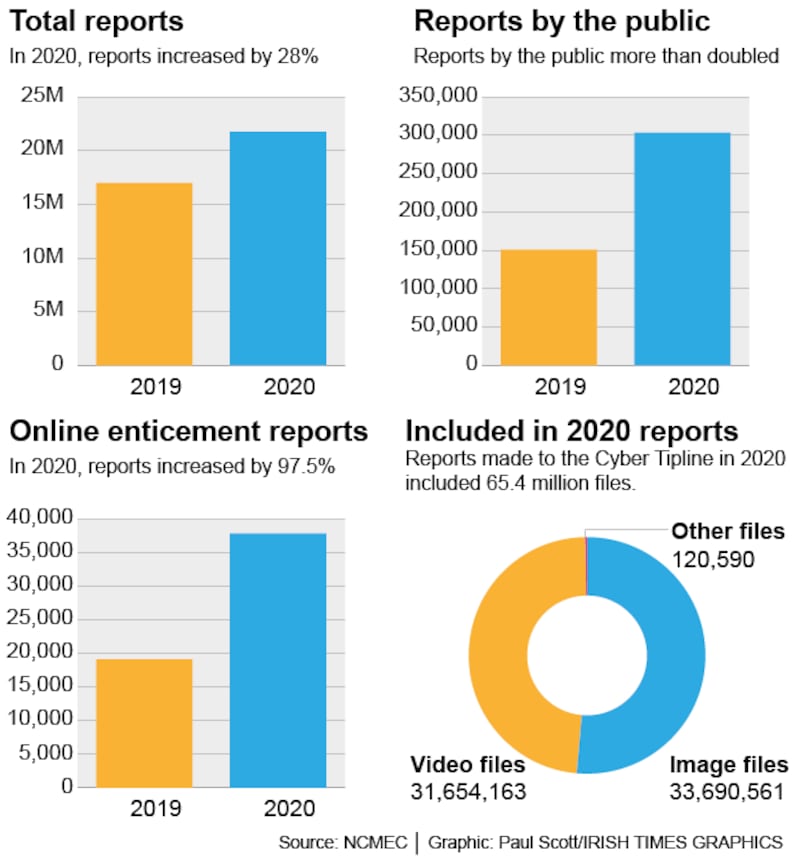The case of Evelyn Ajie, who was sentenced to nine months this week for sending online child abuse material through WhatsApp, can be traced back to an anonymous-looking office building in Alexdandria, Virginia.
The building is the home of the United States’ National Centre for Missing and Exploited Children (NCMEC), specifically its Cybertipline which last year dealt with almost 22 million cases of online child abuse material (known in legislation here as child pornography).
In the case of Ajie, it had alerted gardaí that people in Ireland were sharing videos depicting the sexual abuse of a baby and a 12-year-old boy. As well as possessing the images, Ajie had passed them onto her contacts, making her also guilty of distribution.
On Monday, the 51-year-old was sentenced to nine months in prison in Cork District Court before being released on bail pending appeal.
The journey of the case, from the NCMEC in America to an Irish courthouse, is by no means unusual. In fact the centre is responsible for the vast majority of successful online child sexual abuse prosecutions in Ireland.
According to figures provided to The Irish Times, since 2019 the NCMEC has alerted gardaí to 13,612 suspected cases of online child sexual abuse believed to be linked to an Irish suspect or victim.
Last month the EU Commissioner for Home Affairs Ylva Johansson said about 80 per cent of reports received by gardaí on online child sex abuse come from the NCMEC, with the remaining 20 per cent coming from parents or guardians.

International dimension
"Increasingly our work has been taking on an international dimension," said Rebecca Sternberg who is responsible for liaising with international law enforcement and non-government agencies. "We have a very good relationship with law enforcement worldwide."
According to Sternberg, their work starts when the agency receives information from the public or, more commonly, an electronic service provider (ESP) such as Facebook or Google.
“Our job is to find the most appropriate law enforcement agency to send them to,” she said.
“We’re looking for any information provided. Our analysts look for email addresses, names, screennames, phone numbers.”
Once analysts are happy they have identified the suspected offender's or victim's nationality, they upload the information to a portal which can be accessed by police agencies worldwide. In Ireland's case that is the Garda National Cybercrime Bureau.
Sternberg stressed the NCMEC itself is not itself an investigative agency. “Our job is just to pass it through.”
The centre is funded by the US Department of Justice and through donations, meaning its primary responsibility is to US law enforcement agencies. Ireland and other countries benefit from its work without having to foot any of the bill.
Sternberg said it is difficult to say if the problem of online child abuse is getting worse internationally. The increase in reports, 28 per cent between 2019 and 2020, could be partly down to improved methods employed by ESPs in detecting illegal material.
More proactive
“Companies are becoming more robust in detecting material. They are using hashing or other techniques and are being a little bit more proactive,” she said.
The number and variety of companies which sent tip-offs to the NCMEC last year is staggering. As might be expected, Facebook topped the table with more than 20 million reports.
Other companies include Airbnb (25 reports), Reddit (2,233) and Zoom (499). Perhaps most worrying are the number of reports coming from services which specifically attract children. Tik Tok registered 22,292 reports while 2,203 came from Roblox, a popular children's online game. Two reports came from the Walt Disney Company.
In total, the NCMEC dealt with about 65 million files in 2020, split about evenly between video and image files.
The disturbing nature of the material means it can be a difficult job for analysts, says Sternberg, who along with her 80 colleagues, has been largely working from home since the pandemic hit a year ago.
“It’s challenging work. We have a great team. It’s a very close knit group.” The NCMEC has a “safe-guard programme” in place for staff and a psychiatrist they can access whenever they need, she said.
Covid-19 has changed its work significantly, particularly in the area of online child grooming. Since the start of the pandemic, there has been a roughly 97 per cent increase in “online enticement reports”, which numbered almost 40,000 in 2020.
Pandemic
“Children are online more, whether it’s online learning or gaming. We’re seeing a lot more grooming and enticement because of this access,” says Sternberg.
There is also evidence the pandemic is increasing the risk to children in Ireland.
According to Garda Commissioner Drew Harris there was a "startling and shocking" 26 per cent increase in tip-offs from the NCMEC between March and May last year.
This appears to have balanced out somewhat over the remainder of 2020. In total, there was a 4.5 per cent increase in tip-offs to gardaí compared to 2019.
The main problem for the Garda is not a lack of tip-offs, it is a lack of resources to process them. In most cases, once gardaí get a tip, they must arrest the suspect and seize their devices for forensic examination.
In its report on the Garda for 2020, published on Friday, the Policing Authority noted with concern there is a roughly two-year backlog for the examination of devices by gardaí. This is despite significant additional resources being assigned to the cybercrime unit.
The result is a delay of five years or more in the prosecution of some online child abusers.










